H. Abea*,
H. Saitohb, T. Kusawakeb, H. Nakaoc, Y.
Matsuod, K. Ohshimab, Y. Morikawaa, H.
Matsumotoa
aDepartment of Materials Science and Engineering, National Defense Academy,
1-10-20 Hashirimizu, Yokosuka 239-8686, Japan
bInstitute of Materials Science, University of Tsukuba, 1-1-1 Tennoudai,
Tsukuba 305-8573, Japan
cPhoton Factory, Institute of Materials Structure Science, High Energy Accelerator
Research Organization, 1-1 Oho, Tsukuba 305-0801, Japan
dDepartment of Physics, Nara Women's University,
Kitauoya-Higasi, Nara 630-8506, Japan
J. Alloys and Comp. 342, 241 (2002).
Abstract
The diffuse scattering from atomic short-range order (SRO) associated with an order-disorder transformation was observed in single decagonal quasicrystals of Al72Ni20Co8. The diffuse scattering was distributed around the superstructure reflections.
The correlation length of the diffuse scattering was estimated to be 2.8
nm at room temperature and developed into more than 11.0 nm on the superstructure
phase at high temperature. Full width at half maximum of Bragg reflections
increased monotonically above the transformation temperature, Tc2. On the other hand, SRO diffuse intensities decreased gradually in the
same temperature region. Moreover, hysteresis of SRO diffuse scattering
appeared above Tc2. These behaviors at high temperature originate in the thermally activated
fluctuations.
Keywords: Quasicrystals; X-Ray diffraction; Synchrotron radiation
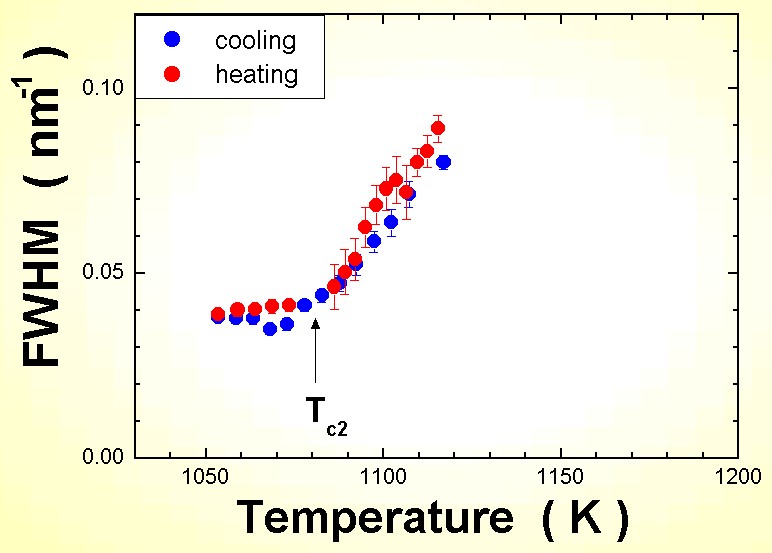 |
Fig. 1 Temperature dependence of FWHM for a radial scan of
Bragg reflection. Temperature cycle contains two parts; firstly cooling
from 1117 down to 1053 K and secondary heating from 1053 up to 1115 K.
FWHM increased gradually above 1083 K, which is transformation temperature
from S1- to (S1+S2)-superstructure. FWHM of Bragg reflection is almost
reversible, though intensity was almost constant during this temperature
cycle. |
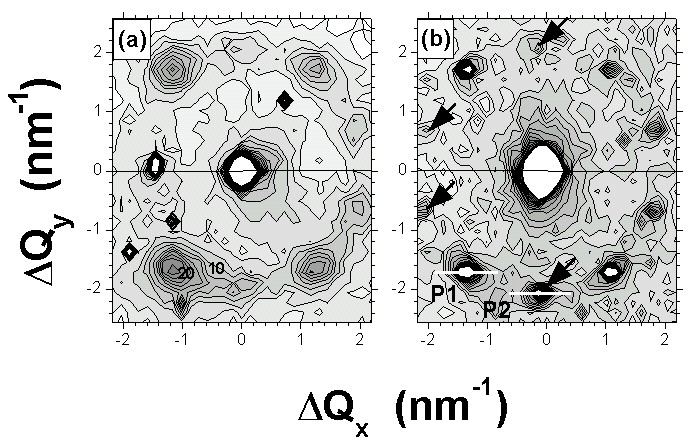 |
Fig. 2 The distributions of the SRO diffuse scattering around
Bragg reflection at (a) room temperature and (b) 1117 K in ANC1. Arrows
shown in Fig. 2(b) presents the additional diffuse peaks in the center
of S1-superstructure positions. Diffuse intensities of the labeled diffuse
peaks of P1 and P2 were measured during the temperature cycle in Fig. 3. |
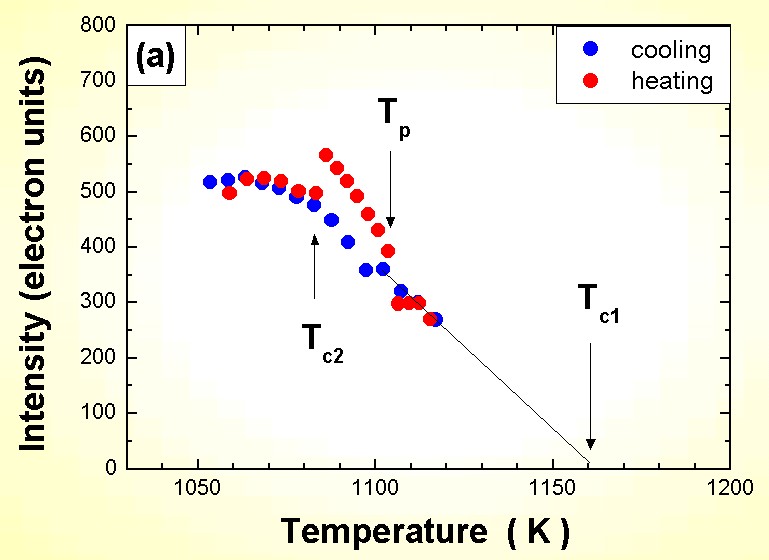 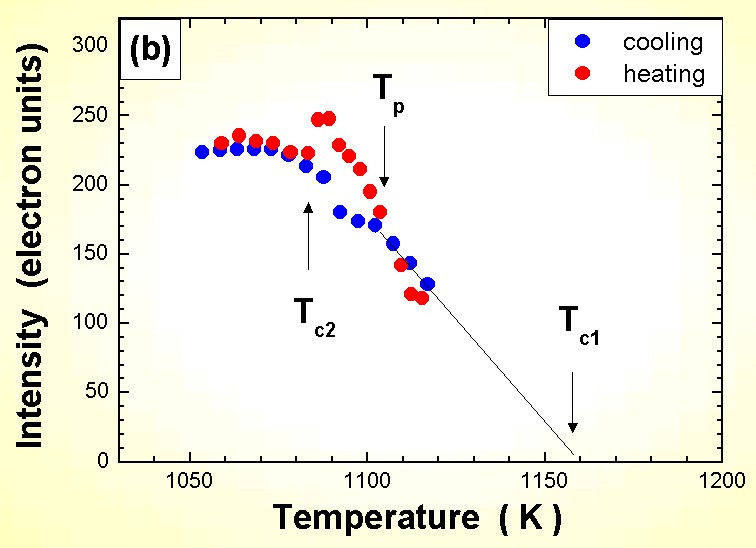 |
Fig. 3 Temperature dependences of diffuse scattering of ANC1 at (a)
P1 and (b) P2. At the transformation temperature, Tc2, a discrete change
is seen both at P1 and P2. Hysteresis appears at peculiar temperature,
Tp, which is below Tc1. Tc1 is obtained by the extrapolation
of temperature dependence of diffuse intensities. |
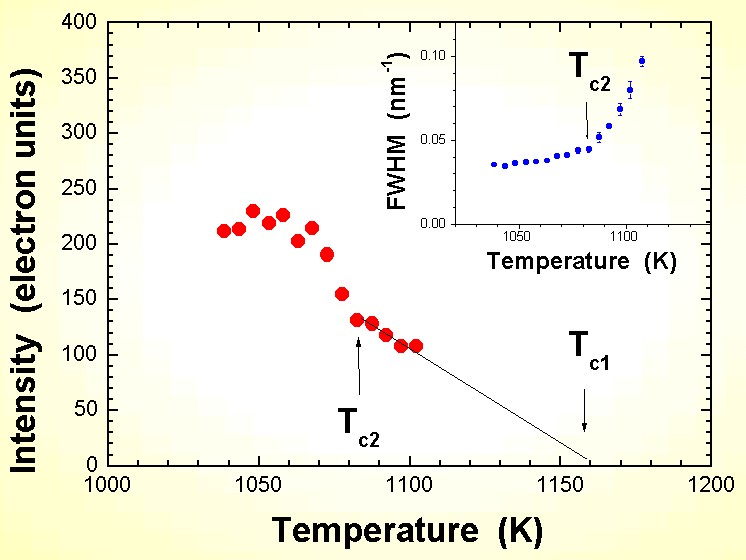 |
Fig. 4 Temperature dependences of diffuse scattering and FWHM of Bragg
reflection of ANC2 at P1 on the cooling process. ANC2 has similar temperature
dependence of ANC1. |
References
[1] S. Ritsch, C. Beeli, H. ?U. Nissen, T. Godecke, M. Scheffer and R.
Luck, Philos. Mag. Lett. 74 (1996) 99.
[2] A. P. Tsai, A. Fujiwara, A. Inoue and T. Msumoto, Philos. Mag. Lett. 74 (1996) 233.
[3] K. Saitoh, K. Tsuda, M. Tanaka, K. Kaneko and A. P. Tsai, Jpn. J. Appl. Phys. 36 (1997) L1404.
[4] E. Abe, K. Saitoh, H. Takakura, A. P. Tsai, P. J. Steinhardt and H. ?C. Jeong, Phys. Rev. Lett. 84 (2000) 4609.
[5] H. Takakura, A. Yamamoto and A. P. Tsai, Acta Cryst. A57 (2001) 576.
[6] H. Abe, Y. Matsuo, H. Saitoh, T. Kusawake, K. Ohshima and H. Nakao,
Jpn. J. Appl. Phys. 39 (2000) L1111.
[7] T. C. Lubensky, J. E. S. Socolar, P. J. Steinhardt, P. A. Bancel and P. A. Heiney, Phys. Rev. Lett. 57 (1986) 1440.
[8] K. Hiraga, F. J. Lincoln and W. Sun, Mater. Trans. JIM 32 (1991) 308.
[9] H. Abe, N. Tamura, D. Le Bollofh, S. C. Moss, Y. Matsuo, Y. Ishii and J. Bai, Mater. Sci. Eng. 294-296 (2000) 299.
[10] Y. Ishii, Mater. Sci. Eng. 294-296 (2000) 377.
[11] K. Edagawa, H. Sawa and S. Takeuchi, Phil. Mag. Lett. 69 (1994) 227.
[12] K. Hradil, T. Proffen, F. Frey, S. Kek, H. G. Krane and T. Wroblewski,
Phil. Mag. B71 (1995) 955.
[13] A. Baumgarte, J. Schreuer, M. A. Estermann and W. Steurer, Phil. Mag. A75 (1997) 1665.
[14] K. Edagawa, K. Suzuki, S. Terauchi, Phys. Rev. Lett. 85 (2000) 1674.
[15] S. Hashimoto, Acta Cryst. A56 (2000) 85.
[16] M. Honal, T. Haibach and W. Steurer, Acta Cryst. A54 (1998) 374.
[17] M. Widom, I. Al-Lehyani, Y Wang and E. Cockayne, Mater. Sci. and Eng. A294-296 (200) 295.
 Back
to Publications List
Back
to Publications List
ab@nda.ac.jp
Department of Materials Science and Engineering
National Defense Academy
Last Modified: April 1, 2009




